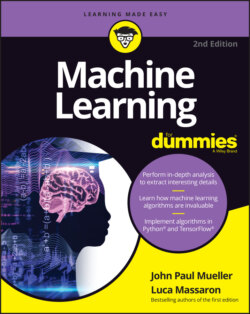Читать книгу Machine Learning For Dummies - John Paul Mueller, John Mueller Paul, Luca Massaron - Страница 55
Using machine learning in industrial settings
ОглавлениеMachine learning is already playing an important part in industrial settings where the focus is on efficiency. Doing things faster, more accurately, and with fewer resources helps the bottom line and makes an organization more flexible with a higher profit margin. Fewer mistakes also help the humans working in an organization by reducing the frustration level. You can currently see machine learning at work in
Medical diagnosis
Data mining
Bioinformatics
Speech and handwriting recognition
Product categorization
Inertial Measurement Unit (IMU) (such as motion capture technology)
Information retrieval
This list just scratches the surface. Machine learning is used a lot in industry today, and the number of uses will continue to increase as advanced algorithms make higher levels of learning possible. Currently, machine learning performs tasks in a number of areas that include the following:
Analyzation: Determining what a user wants and why, and what sort of patterns (behaviors, associations, responses, and so on) the user exhibits when obtaining it.
Enrichment: Adding ads, widgets, and other features to an environment so that the user and organization can obtain additional benefits, such as increased productivity or improved sales.
Adaptation: Modifying a presentation so that it reflects user tastes and choice of enrichment. Each user ends up with a customized experience that reduces frustration and improves productivity.
Optimization: Modifying the environment so that the presentation consumes fewer resources without diminishing the user experience.
Control: Steering the user to a particular course of action based on inputs and the highest probability of success.
A theoretical view of what machine learning does in industry is nice, but it’s important to see how some of this works in the real world. You can see machine learning used in relatively mundane but important ways. For example, machine learning has a role in automating employee access, protecting animals, predicting emergency room wait times, identifying heart failure, predicting strokes and heart attacks, and predicting hospital readmissions. (The story at https://www.forbes.com/sites/85broads/2014/01/06/six-novel-machine-learning-applications/ provides details on each of these uses.)
